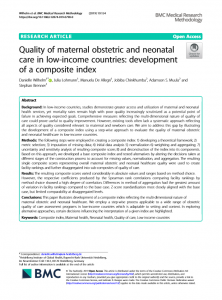
Background
In low-income countries, studies demonstrate greater access and utilization of maternal and neonatal health services, yet mortality rates remain high with poor quality increasingly scrutinized as a potential point of failure in achieving expected goals. Comprehensive measures reflecting the multi-dimensional nature of quality of care could prove useful to quality improvement. However, existing tools often lack a systematic approach reflecting all aspects of quality considered relevant to maternal and newborn care. We aim to address this gap by illustrating the development of a composite index using a step-wise approach to evaluate the quality of maternal obstetric and neonatal healthcare in low-income countries.
Methods
The following steps were employed in creating a composite index: 1) developing a theoretical framework; 2) metric selection; 3) imputation of missing data; 4) initial data analysis 5) normalization 6) weighting and aggregating; 7) uncertainty and sensitivity analysis of resulting composite score; 8) and deconstruction of the index into its components. Based on this approach, we developed a base composite index and tested alternatives by altering the decisions taken at different stages of the construction process to account for missing values, normalization, and aggregation. The resulting single composite scores representing overall maternal obstetric and neonatal healthcare quality were used to create facility rankings and further disaggregated into sub-composites of quality of care.
Results
The resulting composite scores varied considerably in absolute values and ranges based on method choice. However, the respective coefficients produced by the Spearman rank correlations comparing facility rankings by method choice showed a high degree of correlation. Differences in method of aggregation had the greatest amount of variation in facility rankings compared to the base case. Z-score standardization most closely aligned with the base case, but limited comparability at disaggregated levels.
Conclusions
This paper illustrates development of a composite index reflecting the multi-dimensional nature of maternal obstetric and neonatal healthcare. We employ a step-wise process applicable to a wide range of obstetric quality of care assessment programs in low-income countries which is adaptable to setting and context. In exploring alternative approaches, certain decisions influencing the interpretation of a given index are highlighted.